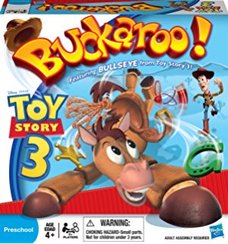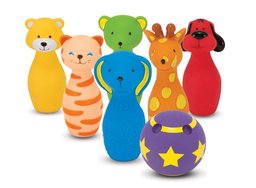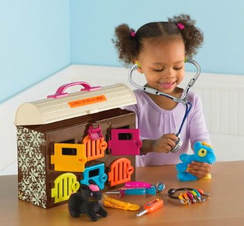It’s time again for our monthly segment: Favorite Toys Without Batteries! As we talked about here, here, here, and here we love toys without batteries. Below is The Speech Space’s July list of great toys that don’t make noise, so that you can get your child talking more while you play!

Buckaroo:
This game makes it really easy to work on expanding your child’s vocabulary and basic concept knowledge in a fun way! When we play this game, everyone playing describes the supply they want and the other players have to guess which supply is being described. Work on having your child use different descriptors to describe the item they want to get (e.g., attributes–color, shape, size, number, function, and category). If your child is unable to do this by themselves, you can help by prompting them (e.g., “What color is it?”; “What size is it? Small, medium or big?”; “What group does it belong to?”). Once the game is over you can work on these same concepts in a receptive language task (vs. during the game when you are working on your child’s expressive language skills). You can work on your child’s receptive language skills by giving them the clues or descriptions to clean up the correct supply you describe (e.g., “Get the one that is green, big in real life, has spikes, is a type of plant, and we find it in the desert”– the cactus!).
**Pro-tip: While you are playing you may need to remind your child to put the items on the saddle very carefully otherwise he will Buckaroo! This game is typically easier for children in Pre-K and older because of the need to self-monitor how gently you put items on the saddle.

Bowling
Toy bowling sets can be inexpensive and fun for the younger crowd. We like to use them with our early talkers as a way to really encourage using language during play. While setting up the pins you can use functional words (e.g., “Up-up-up” for each pin), name the pins (e.g., animals), or even name the colors or count the pins as your child gets older. Have your child tell WHO and WHAT they should do (“I roll the ball” or “You roll the ball”, etc.), or HOW you should roll it (“Through my legs” or “Under the table”, etc). After they’ve rolled the ball, talk about what happened to the pins, using quantitative concepts like “all” or “one” (e.g., “One fell down!” or “They all fell down!”).

Critter Clinic
This veterinary clinic is such a fun toy for kids 3 years and older. When we use this toy in therapy sessions we like to put a bunch of small stuffed animals inside each “room” (we found a bunch of old Beanie Babies on eBay for under $8). Have your child tell you which color door they will open and then give your child clues as to what the animal inside will be. This is a great way to work on early inferencing and understanding complex language. Once they open the door and find the animal, have them tell you about it (where the animal lives, defining features, color, parts of the animal, etc) to increase their expressive vocabulary. Once all the animals are out, use the doctor tools to have your child pretend to be a veterinarian. During this time you can help your child with understanding the specific names for each tool and it’s function. If you have extra band-aids (or even some tape and a tissue), have your child tell you where the animals have boo-boo’s and give them bandages.
Check back on The Speech Space blog for other fun ideas, toys and games you can do with your child to help increase their communication development.
And as always, if you have questions or concerns about your child’s development, contact us at The Speech Space! We offer free screenings, which take approximately 30 minutes, and can help identify potential problems.
